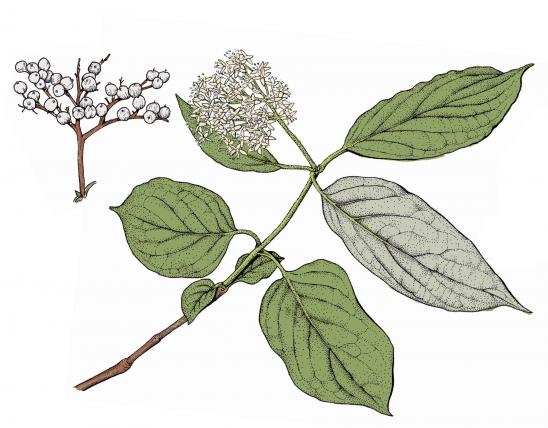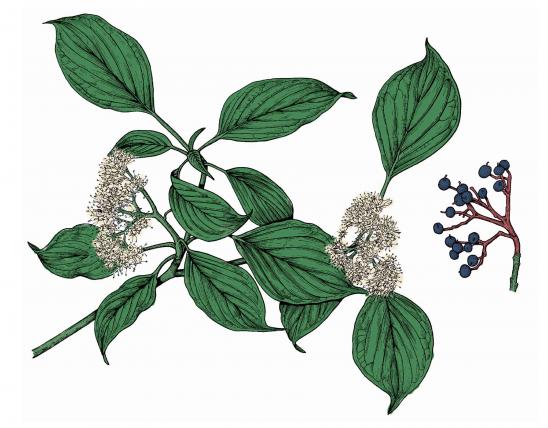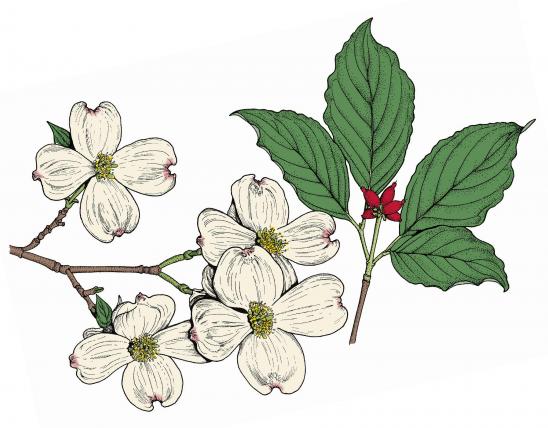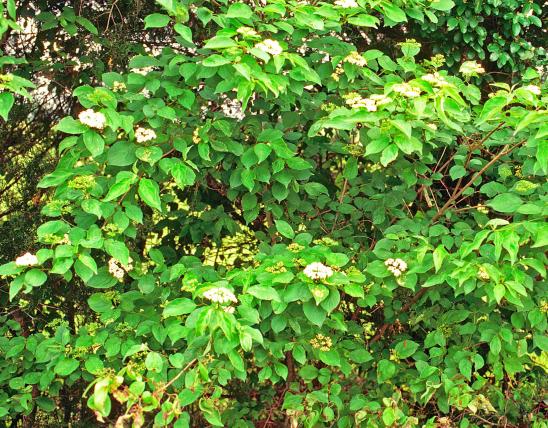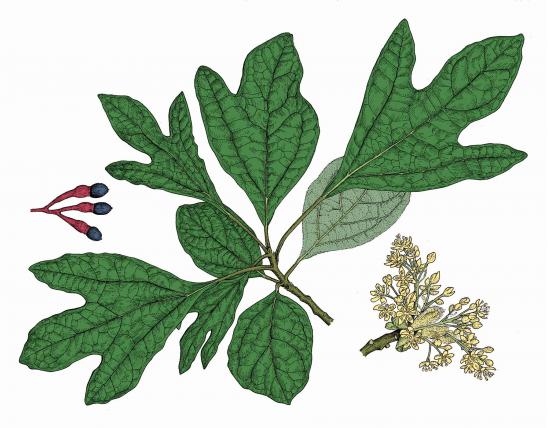
Swamp dogwood, or silky dogwood, is an open, irregularly branched shrub that usually occurs as a solitary individual, usually in wet locations. Rarely, it takes the appearance of a small tree.
The leaves are opposite (alternate in one of our species), simple, entire, egg- to lance-shaped (longer than broad). Uppersides smooth, dark green; undersides paler and may be smooth or covered with minute, appressed white hairs. The 5 or 6 pairs of secondary leaf veins are strongly arched toward the leaf tip, becoming irregularly fused toward the leaf margin. The leaf stalk is hairy.
The flowers are in clusters at the tips of branches, with 4 white petals that are not very showy; appear May–July; in flat or sometimes indented to round-topped clusters, on very hairy, yellowish-brown stalks.
The fruits are berrylike (technically, drupes), spherical, blue (sometimes with white blotches), each fruit with 1 or 2 oblong seeds. The style from the flower persists as a tiny stalk at the tip of each fruit. Fruit stalks become reddish brown as fruits mature.
The twigs are slender, reddish brown to purplish brown, and densely hairy when young. Older twigs lack hairs.
Trunk bark is usually tight, red, with small, tan, slightly raised dots; some stems have shallow longitudinal splits in the outer bark.
Similar species: Missouri has 4 other species of dogwoods. Swamp dogwood’s key characters include its silky-hairy, often maroon twigs, smooth leaves with 5 or 6 pairs of side veins, club-shaped style (broadened toward the tip), relatively long sepals, lack of showy bracts, and blue fruits.
- Gray dogwood (stiff dogwood) (C. foemina) usually grows in swamps and other wet locations. It is scattered nearly statewide but absent from most of the Unglaciated Plains of northern Missouri. Identify it by its opposite leaves with mostly 3 or 4 pairs of side veins (not 5 or 6), light blue or mottled blue-and-white fruits, and young twigs smooth (not hairy).
- Rough-leaved dogwood (C. drummondii) commonly occurs in disturbed habitats and tolerates drier conditions than other dogwoods. It occurs statewide. It can hybridize with other dogwoods, and you may find an individual plant or a small colony (spread via root sprouts) with characteristics intermediate between the two parent species. These hybrids, if you find any, will be very hard to identify. Note the roughened upper leaf surface, the secondary veins somewhat crowded toward the leaf base (most secondary veins arise in the basal half of the leaf), and the white fruits.
- Alternate-leaved dogwood (C. alternifolia) is the only Missouri dogwood with alternate (not opposite) leaves. Fruits are dark blue or bluish black.
- Flowering dogwood (C. florida) prefers well-drained, acid-based soils and most common in the Ozarks. It is identified by its combination of opposite leaves, dense flowerheads with 4 showy bracts beneath the yellowish clusters of inconspicuous flowers, and oval red fruits. It is Missouri’s official state tree, producing lovely boughs of white inflorescences (flower clusters) in our springtime forests.
Height: 3 to 13 feet.
Scattered nearly statewide.
Habitat and Conservation
This dogwood grows in wet locations, including banks of streams and rivers, margins of ponds and lakes, fens, bottomland forests, low moist places in prairies, and pastures, fencerows, railroads, and roadsides.
Status
Native Missouri shrub or small tree. Very popular native landscaping plant, with high ornamental and wildlife value.
Human Connections
An Algonquian name for tobacco, kinnikinnick, has been applied to this and several other species of dogwood. Native Americans removed the outer bark, then scraped and dried the inner bark for smoking. It is fragrant, and many tribes were fond of it.
The species name, amomum, is a Greek name of a spice plant and means “purifying,” referring to its ritual use by Native Americans.
Dogwoods are prized for their hard wood, which withstands sudden hard shocks and wears smoother, not rougher, with use. It has been used for making a wide variety of tools and other items.
Several dogwood species are cultivated in the Midwest as hedges, specimen plants, and ornamentals — especially cultivars with red or yellow stems. The deep blue berries look handsome against the purplish fall foliage.
Dogwoods contribute to the overall look of fall color, and fall color is good for Missouri tourism.
Ecosystem Connections
At least 10 species of birds, including ruffed grouse, northern bobwhite, and wild turkey, eat the fruit. Rabbits, woodchuck, raccoon, and squirrels also eat the fruit. Wood ducks are known to eat the fruits in late summer and fall, before and after ripening. They have been seen reaching as far as they can from the water to strip the shrubs of fruit.
Where it grows on stream banks, swamp dogwood provides escape for wood ducks and cover for their broods. It also provides cover for woodcock.
Dogwoods are larval food plants for several groups of butterflies and moths, including the spring azure, dogwood thyatirid, one-spotted variant, friendly probole, and false crocus geometer. Many other insects feed on or drink sap from the foliage; one example is the dogwood spittlebug, a squat, black-and-yellow hopping insect.
Plants that grow along streams play important roles in stabilizing the banks against flood waters, maintaining the shape of the stream and preventing erosion.

























